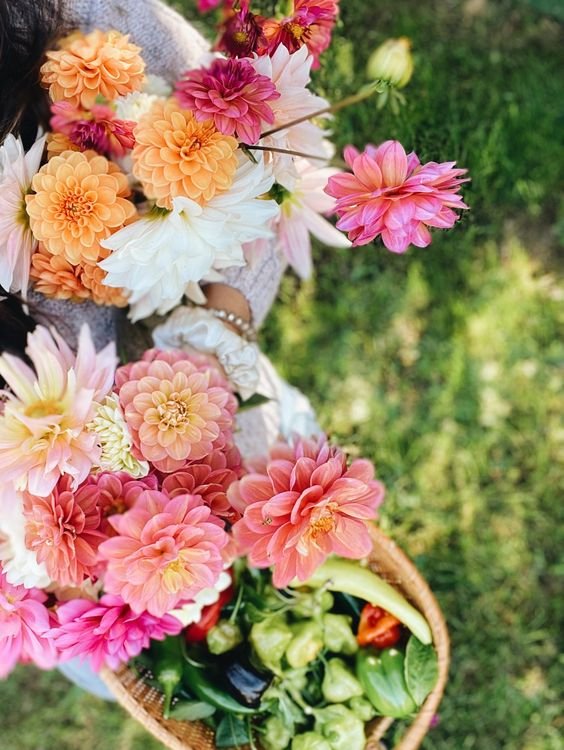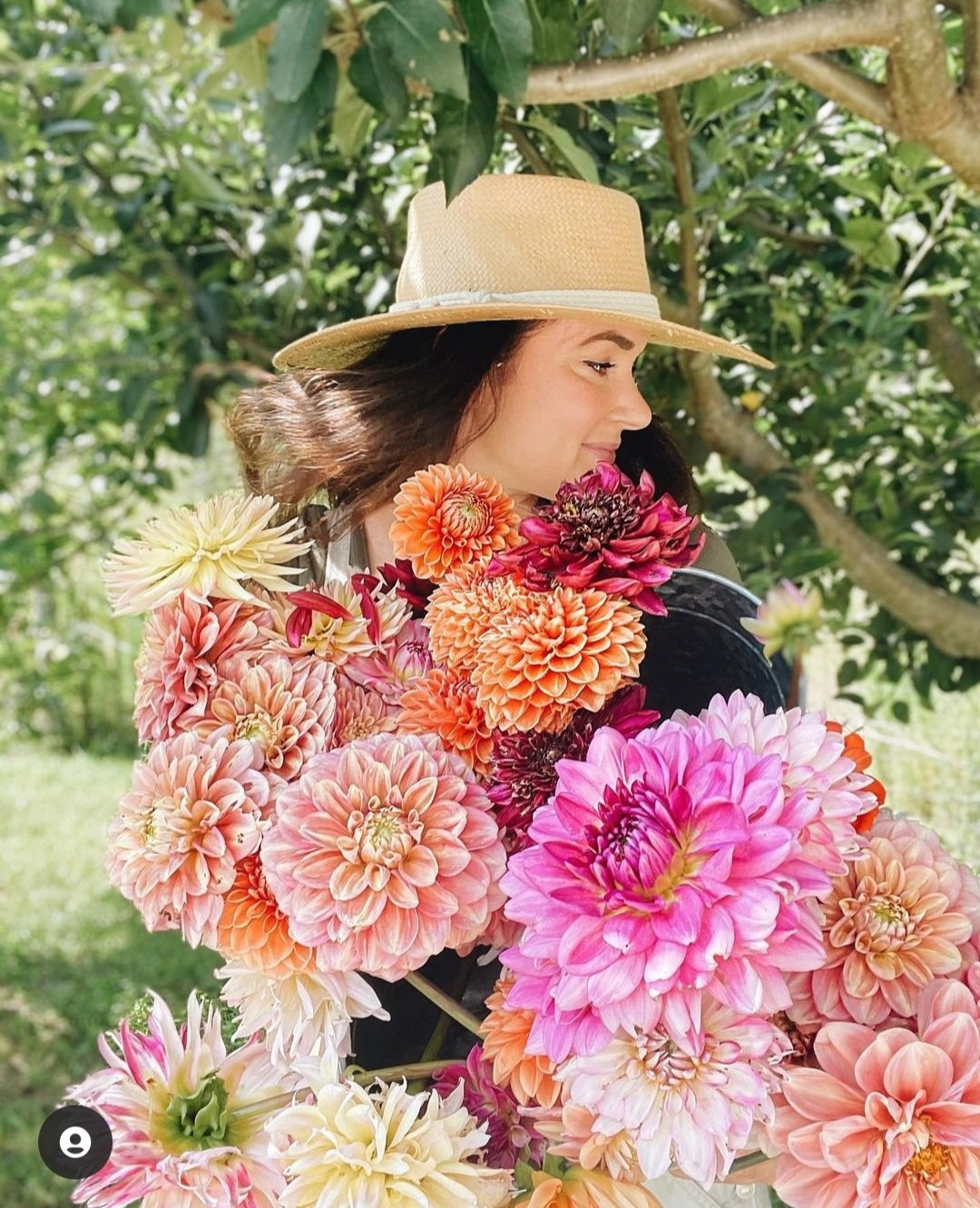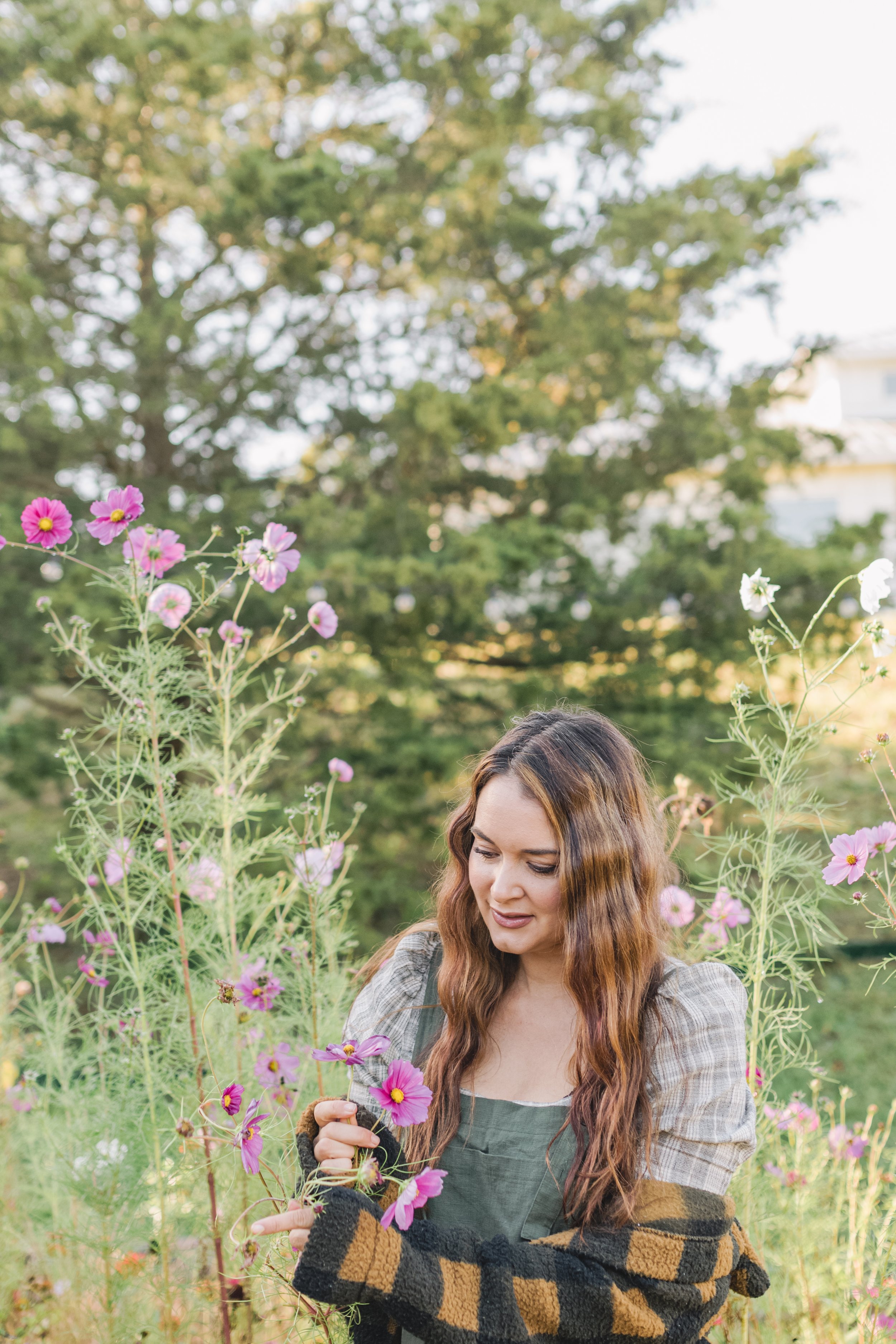A Beginner's Guide To Growing Gorgeous Cut Flowers
If we could see the miracle of a single flower clearly our whole life would change ~ Buddha
And what a miracle a flower is! To think something so undeniably beautiful, with its vivid colors and intricate details, came from a simple seed.
Something so spectacular can indeed change our whole life, figuratively and literally. Their smell brings back memories, their beauty adds color to our surroundings, and they provide endless joy for the soul!
Many of us dream about creating a cut flower garden. It's easy to fall in love with the image of wandering through the garden and harvesting a plethora of vibrantly colored blooms to proudly display in our homes.
And, friend, growing cut flowers is really not that hard!
Not only is it magical, but it is way cheaper, more sustainable, and you can grow your favorites instead of settling for what's available at the store or florist.
Continue reading for my steps for growing cut flowers, easy flower varieties for beginners, where to get seeds, tips, and how to harvest cut flowers.
Cut flower varieties for beginners
STEPS for growing cut flowers
Determine what do you like
First, think about what flowers you like and want to grow.
How will you use them:
For elaborate arrangements or simply a splash of color?
Do you want flowers with a long vase life or something new every other day?
Do you want to grow flowers to dry to make crafts?
Do you need flowers for weddings or other events?
Do you want flowers that are pollen-less due to allergies?
Once you have a clear idea of what you will use your cut flowers for most, deciding which to grow and how to go about it will be easier.
Have a plan
When planning a cut flower garden, map out your design and garden layout on paper.
Scan your garden for where you want or have to plant your flowers, and then draw out a scale replica of your backyard, including your new addition. This way, it will be easier to visualize how your cut flower garden will work in the space and help you avoid issues once you start planting.
Tip! Organize your cut flower garden so that the tallest plants, like sunflowers, are at the back, medium-sized ones, like zinnias, in the middle, and short-stature plants at the front.
prepare your soil
This is probably the most crucial factor when it comes to growing flowers or any garden-related item. If the soil is not good, the flowers will not grow properly.
Loose soil that has good drainage is always best. Raised beds help a lot with drainage.
However, you don't have to use raised beds. Just make little mounds with your soil if you're planting directly into the ground so that the water can drain. You don't want water to sit and be stagnant.
Ensure your soil has good organic fertilizer (we use alpaca poop), a healthy amount of compost, and some mulch or straw to help retain moisture and keep weeds at bay.
When mixing your soil, it's always good to use peat moss, molasses, kelp, and compost for healthy, bountiful flowers.
READ MORE: Make the best organic garden soil for vegetables and flowers
Sunshine is your best friend
Most flower varieties love lots of sunshine to grow, bloom, and produce seeds. The more sun, the more pretty flowers!
Therefore, think about that when you decide on where to plant your flowers. Make sure they have full sun for most of the day.
Decide on Seeds or seedlings
I've done both!
While many annual flowers are fast-growing and can be directly sown in the spring garden, seedlings will give you a head-start on the season.
If you have the time to start seedlings, start them a few weeks or even a month before your last frost date. That way, they are already growing when you plant them, and you'll have blooms sooner!
However, once there is no threat of frost, it's okay to plant seeds directly in the ground. It should sprout and do okay. Of course, it will take longer to see results, but it is easy, and some flowers' roots will be more settled this way.
Plant The Right Time of year
I would say the best time of year to plant most cut flowers is late spring, two weeks after the last frost, but it depends on the flower variety.
Most of these flowers will be annuals, so you can't really plant in fall, hoping they'll go dormant and pop up again next year. Some perennial flowers will come back every year, but these are limited.
However, dahlias are the exception. You can unearth the tubers and store them in a cool, dark place through the winter and then replant them again the following spring!
And, of course, most of us want a non-stop supply of beautiful blooms during most of the year!
The secret? Succession planting. Succession planting is a way to extend your harvest by staggering plants or flowers with staggered maturing dates so they bloom at different times.
After a few weeks of intense blooming, flowering of many annuals declines, or the bloom size shrinks. Planting new seedings every two to three weeks ensures a steady supply of cut flowers throughout spring, summer, and even sometimes into autumn.
Fertilize to keep things going
To get those beautiful flowers, your plant needs food and boosters! Add fertilizer when planting and every two to three weeks during the growing season.
A liquid organic flower fertilizer, compost, or manure will increase flower production.
READ MORE:
CUT FLOWER VARIETIES FOR BEGINNERS
The ideal cut flower garden should have a nice mix of annual and perennial flowers so you have some beautiful blooms throughout the season.
Annual flowers are what their name suggests - they will not return the following year. But they do produce blossoms all season. Some annual cut flowers include cosmos, larkspur, sweet peas, sunflowers, and zinnias.
Perennials will return year after year. However, they usually have a significantly shorter bloom duration. Some perennial cut flowers include yarrows, garden phlox, Japanese anemones, peonies, veronicas, and dahlias.
My advice would be to grow cut flowers that produce more as you pick them to form the backbone of your cut-flower patch.
So make sure to include a variety of hardy and semi-hardy annuals. Include a wonderful assortment of cut-and-come-again kinds, such as cosmos, zinnias, scabious, and sweet peas, which will produce more blossoms after being cut.
The flowers below are ones I love and have found relatively easy to grow for beginners. They are also fantastic pollinators. There are MANY other varieties.
I love to mix all these varieties, but if you'd like a more uniform look, plant them in separate sections so they don't grow into each other.
Cosmos
I love how these are a bit more whispy and airy.
Cosmos are very low maintenance and have a long vase life. They are more delicate and take longer to bloom than zinnias, but they still add a nice touch. If you deadhead or pick them often, they will provide flowers until October or the first frost.
Start cosmos seeds indoors in March-April, or direct sow in May. You can expect seedlings about three weeks later (all frost should have passed when they emerge). Plant out seedlings once the frosts have passed in late May or June.
Compact varieties can grow to around 2 feet, while tall varieties reach over 4 feet tall. Taller varieties will need staking to support them.
Dahlias
Dahlias may not be the easiest cut flowers for beginners, but they are spectacular and deserve a spot here!
Dahlias are not grown from seeds but from tubers. Tubers have multiple growing points, called eyes, from which the stems grow.
Plant dahlia tubers directly in the ground in spring when the soil has warmed up, and there is no chance of frost. You can also plant them in pots before the last frost and then transplant them in spring when the danger of frost has passed.
Dahlias can grow from 15 inches to more than 6 feet tall.
READ MORE:
Sunflowers
Sunflowers are very easy to grow, and annual sunflowers bloom from summer through October.
Sow seeds of annual sunflowers outside once the fear of frost has passed and continue doing so every few weeks to have an endless supply of blooms until the first freeze.
They can be started inside if you have a short growing season.
Sunflowers can grow up to 7 feet tall, making them an excellent flower for the back of your cut flower garden.
Be careful when using fertilizer for sunflowers, as too much nitrogen can inhibit flowering. Water deeply so their roots will grow down rather than out.
Sweet Peas
Sweet peas are another excellent cut flower thanks to their array of pretty colors, lovely scent, and ability to produce many blooms over a long cutting period. Yes, they are a bit more tricky to grow, but their beauty makes up for it!
Sweet peas, despite their fragile look, are surprisingly durable. Plant them in USDA Hardiness Zone 7 or colder when the soil is dry enough to work in late winter or early spring. Do not wait until the last frost to sow! It will likely be too late.
Mild winter climates (zones 8-10) should plant sweet peas in late fall (November) so they can bloom in late winter, or early spring.
Most sweet peas are grown as vines, reaching 4 to 6 feet tall.
We don’t have sweet peas yet in the garden, but maybe one day!
Image from marthasteward.com
Spring bulbs
Spring-flowering bulbs are some of the easiest flowers to grow, kind of like plant-forget-and-tada! Some varieties include tulips, irises, daffodils, hyacinths, grape hyacinths, alliums, crocus, and bluebell.
Spring-flowering bulbs need to be planted in fall, 6-8 weeks before the ground freezes up. It's also best to plant them only when your zone's average nighttime temperatures are between 40-50 Degrees F. This is an excellent measurement to ensure your soil is cool enough.
Most spring-flowering bulbs need several cold weeks of chilling time (12-15 weeks) to flower to their full potential in spring. Exactly when to plant bulbs will depend on your zone.
READ MORE: Spring bulb planting tips
Zinnias
These have fast become my FAVORITE flowers!! They are pretty easy to grow, come in a million different colors, and last all summer! Plus, they're super fast from seed to bloom.
Zinnias thrive in hot, dry conditions and will continue to bloom until the first frost. They last forever in a vase and are just so very pretty!
Sow zinnias indoors from February until April, or directly outdoors into the soil in May. Space their seedlings around 10 inches apart.
Zinnias can grow up to 4 feet tall, so you can erect horizontal netting a foot above the ground. As they grow, they will grow through the net and not flop over in high winds or heavy rain.
WHERE TO GET YOUR SEEDS
There are so many options for this!! I've gotten most of my seeds from Tractor Supply, Bakers Creek Seeds, and more!
I do, however, splurge sometimes and order some seeds from Floret Flowers. Their germination rate is amazing, and I would definitely recommend them.
My secret flower seed planting trick? Buy seed tape! Seed tape consists of paper tape with seeds infused into it, making it so much easier to plant your flowers in rows. Most of the zinnias in my garden are planted this way.
My favorite is the Simple Solutions Burpee Cut Garden Mix Seed Tape. It comes with Zinnia, Cosmo, and Tithonia seeds. It has worked for me every time! It's almost foolproof, and it's a beautiful variety of flowers.
TIPS FOR GROWING CUT FLOWERS
🌷Have no space for a cut flower garden and beds? Not to worry! If you're a casual cut flower grower and only want a few blooms, you can plant annual flowers in between veggies, among perennials and shrubs, or even in pots and planters.
🌷Once you plant your seeds, you must keep them watered! If the seed starts to sprout but has no water, even for a day, it will die. Keep them watered during those first weeks, and they will continue to grow!
🌷Water plants carefully with a constant jet flow at the base of the plant rather than showering them from above. Watering in the evening is ideal since it allows the plants to absorb what they require overnight.
🌷You must deadhead your flowers. It might feel like you are losing all your blooms, but I promise more will come in their place! This will ensure you have flowers all summer and into the cooler fall months. Cut the flowers that are fading away by making a diagonal cut above the closest set of healthy leaves. A brand new bud will sprout from that spot! It's truly a miracle to see! Do this weekly.
🌷Pinching is beneficial to many plants like zinnias and Celosia. Young plants are pinched to encourage them to branch and produce longer stems. Plants are typically pinched after they reach a height of 10 to 12 inches. Remove the growing tip with your fingertips or a clean pair of pruners, pinching back to a healthy set of leaves.
🌷Consider a raised garden bed for your cut flower garden if you are concerned about the quality and depth of your soil. This gives you complete control over the quality of the soil type and soil health, resulting in improved plant health and productivity.
READ MORE: Raised beds vs. in-ground beds
🌷Plant flowers close together, or place supports to help stop tall plants from flopping over as they grow. Combine plants of similar heights, growing conditions, and flowering times, including both focal flowers and filler plants.
🌷Plant foliage and fillers between your flowers to give your beds a more 3-dimensional look. Some options include Lords and Ladies, rosemary, eucalyptus, and Queen Anne's Lace.
🌷Allow some of your flowers to set seed and gather them to sow the following year. Simply wait for a dry day near the end of summer and collect the dry seeds from a healthy plant. Shake the stem to allow the seeds to fall into a container, or wrap the seed head in a paper bag and cut the stem before hanging it upside down to dry. Remember to label them.
READ MORE: How to save seeds
🌷Share your flowers with others! Why have beautiful blooms if you're the only one to benefit? An elderly lady from my church brings flowers from her garden each week to place up front. It's her gift to us church members each week, and it's amazing. Always find a way to give back somehow!
How To Harvest Cut garden Flowers
When your flowers are about to open up, cut them.
Collect them early in the morning or late in the evening when the stems are full of water and less likely to wilt. Avoid doing so during hot, sunny days.
Follow the stem you want to pick until it meets the main stem, then cut at this point. Leave no portions of the stem behind.
Place the freshly cut flowers into a bucket of water. Leave them in the bucket for a few hours, or even overnight, in a cool place before you start arranging. Off course, this is just a suggestion; if you cannot wait, go on and arrange them in a vase!
Remember, many annuals, such as sweet peas and some perennials, may bloom for longer periods if picked regularly.
Tips To Keep Your Cut Flowers Fresh
🌷First, clean your vase to eliminate harmful bacteria. Scrub it with 1 part bleach to 10 parts water, then rinse thoroughly. Fill your vase with tepid water.
🌷Trim all green and woody stems at a 45-degree angle with sharp scissors and underwater if possible.
🌷Removing excess foliage (and browning petals), especially those under the water line.
🌷Feed your flowers with sugar and keep the water free from bacteria with an acidic solution like vinegar or an alkaline substance like baking soda.
🌷Flowers like roses, tulips, magnolias, daffodils, and hydrangeas prefer acidic solutions. And Carnations, sweet peas. Delphiniums, snapdragons, and sunflowers prefer alkaline conditions. Mix 2 tablespoons sugar and two tablespoons vinegar or baking soda with your water and stir well.
🌷Replace the vase water daily.
Now you are ready to start growing cut flowers, friend!
Don’t be overwhelmed with all the information and advice out there. Simply buy a few of your favorite flower seeds and get planting! You will learn as you go. The secret is to just start!
And I promise, picking flowers from your garden is one of the most magical and rewarding experiences!
I think you’ll love these blogs too:
12 of the easiest flowers to grow in the garden
14 Edible flowers to delight your palate and plate
23 Herbs and flowers for organic pest control in the garden
Love, Annette xx














